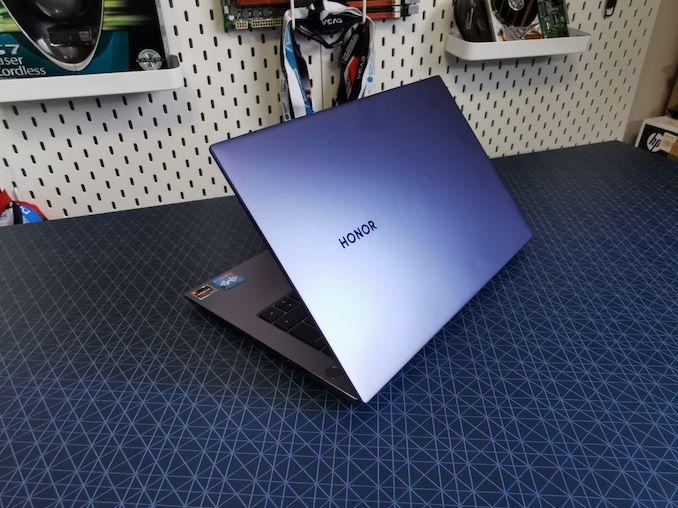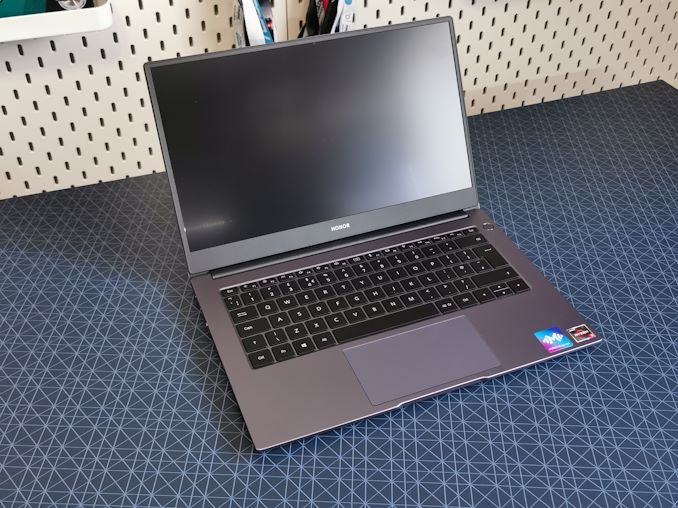Honor Magicbook 14 Notebook Review: Where Style Paints a Picasso
by Dr. Ian Cutress on May 15, 2020 9:00 AM EST- Posted in
- Laptops
- AMD
- Notebooks
- Zen
- honor
- Picasso
- MagicBook
- Magicbook 14
- Ryzen 5 3500U
Conclusions
Over my years as a technology journalist, travelling to events, I’ve used a variety of notebooks for my work. These vary from an old Dell M4400 that weighed over 8 lbs with its two batteries that lasted a total of five hours, down to dual core AMD netbooks, a Cannon Lake laptop with 3 hours battery life, and some extra special thin and light notebooks that last almost all day. There’s even an Arm based notebook in my collection for when I absolutely know I need battery and I only need to charge that once every few days.
My weapon of choice before the global shutdown occurred was the 13-inch Huawei Matebook 13 integrated graphics version (i7-8500U), which I had been using for around ten months since my HP was stolen at Mobile World Congress. One of the best designs I ever had was the Huawei Matebook 13 (2017) model, and I still pine for the day when they requested the sample back – it was an amazing system. These devices have served me well – almost all-day battery life on the aeroplane (when I don’t have a socket), and the design ID was something a bit different to what everyone else had, which was typically Dell XPS 13 units, office-mandated Thinkpads, or Macbooks. Over the years I’ve also used HP Spectre thin-and-light designs, all of which offered the best for a $1200 mid-range product, as well as ASUS Zenbooks.
The Honor Magicbook 14 fulfils almost all my needs here, as much as any of the other previous systems have, for half the price. It is a thin and light design, plenty responsive, with NVMe storage, and good features. Even with all this, I think it is the styling that impresses me most – having a polished space grey chassis with that azure blue chamfered edge is a nice tweak that makes the laptop stand out as something special. As a first attempt at a worldwide laptop, Honor has the fundamentals correct.
There is room for improvement, sure – in order to be taken seriously as a road-warrior type device, it needs 16 GB of memory, and that 240-nit screen needs to be nearer 400 nits. Some users will lament the lack of a touch screen, though some of the big OEMs offer variants with and without it, and Honor may be able to do the same in future. Honor is also late to the market with the Picasso-based Magicbook – it’s coming out at a time when AMD has launched its upgraded Renoir processor line which features better performance and much longer battery life for the same thermal envelope. Laptop manufacturers are also going to be highly competitive, offering some stunning Renoir performance for around the $650 mark, which the Magicbook will have trouble competing against.
As and when Honor updates the Magicbook to AMD’s Renoir processors, this device could really fly. Not only in workload level performance, but things like gaming, and battery life for those on the road. As it stands, the Magicbook 14 I have been testing is still a great device – I cannot believe all of this is available for only $560, honestly. That being said, newer Renoir based devices like the Acer Swift 3 we reviewed recently can be had for as little as $650 today, with Ryzen 7 4700U, 512 GB double storage and better battery life, but lose out on the design.
There is a lot of design ethos here, and I can tell that a lot of passion is built into this machine. For someone who wants a nice-looking machine and cannot find something as competitive at this price point, the Magicbook is a solid option and you will not be disappointed. It is well recommended.
I look forward to seeing the quality and capabilities of what Honor can do in the future. If they can match or better this style, with the latest hardware under the hood for performance and battery life, then it will amplify the already impressive user experience I have had. Along with using the device, I also wrote this review on the Honor Magicbook 14. It did not miss a beat.













88 Comments
View All Comments
Retycint - Friday, May 15, 2020 - link
Weak battery life and poor budget screen. Not a very enticing deal when you can get the Acer Swift 3with better performance, battery life and the same grade of screen. 1 year too late on this model, I'ma fraidsuperflex - Friday, May 15, 2020 - link
Well this might throw a wrench into things.https://www.zerohedge.com/geopolitical/us-blocks-s...
raywin - Friday, May 15, 2020 - link
hidden key camera is epic!raywin - Friday, May 15, 2020 - link
add one extra USB C and an SD card reader, and I would order this post hastedamianrobertjones - Friday, May 15, 2020 - link
"The keyboard is an attempt to copy Apple’s chiclet design"-Were apple the first to use THIS design?
GreenReaper - Saturday, May 16, 2020 - link
Doesn't matter, they could still be copying it from Apple.Spunjji - Monday, May 18, 2020 - link
Nope, I believe it was Sony.Lord of the Bored - Monday, May 18, 2020 - link
Chiclet keyboards show up in the 70s and early 80s. Commodore PET, TI 99/4 and CC40, IBM PC Jr, Sinclair Spectrum to name a few.They didn't last because they were largely reviled and people wouldn't buy a system without a full-travel keyboard.
Now they are a major feature because they make things thinner and more sci-fi-looking. Go figure.
Findecanor - Tuesday, May 19, 2020 - link
Sony VAIO laptops had the first with modern stable scissor switches with chiclet keycaps on top.The 70's and 80's chiclets were not stabilised.
It is stylistic choice only to make them chiclet. The same switches can be made with trapezoidal keycaps.
gagegfg - Friday, May 15, 2020 - link
The Cinebench R20 MT graphic for the Ryzen 9 4900HS is wrong, its score must be in the order of +3000 points, +50% ...Someone already criticized this score in the review of the Acer Notebook with this CPU.